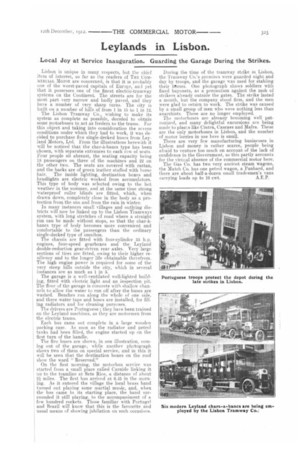Leylands in Lisbon.
Page 13

If you've noticed an error in this article please click here to report it so we can fix it.
Local Joy at Service Inauguration. Guarding the Garage During the Strikes.
Lisbon is unique in many respects, but the chief item of interest, so far as the readers of THE ComMERCIAL :lbTort are concerned, is that it is probably one of the worst-paved capitals of Eurape, aril yet that it possesses one of the finest electric-tramway systems on the Continent. The streets are for the most part very narrow and badly payed, and they have a number of very sharp turns. The city is built on a number of hills of from 1 in 15 to 1 in 1.2. The Lisbon Tramway Co., wishing to make its system as complete as possible, decided to obtain seine motorbuses to act as feeders to the trams. For this object and taking into consideration the severe conditions under which they had to work, it was decided to purchase five single-decked buses from Leyland Motors, Ltd. From the illustrations herewith it will be noticed that the char-a-banes type has been chosen, with separate entrances to each row of seats. Four people sit abreast, the seating capacity being 18 passengers on three of the machines and 22 on the other two. The seats are covered with rattan, and the backs are of green leather stuffed with horse
hair. The inside lighting, destination boxes and headlights are electric worked from accumulators. This type of body was selected owing to the hot weather in the summer, and at the same time strong waterproof roller blinds are fitted, which, when drawn down, completely close in the body as a protection from the sun and from the rain in winter.
In many instances small villages and outlying districts will now be linked up to the Lisbon Tramways system, with long stretches of road where a straight run can be made without stops, so that the char-abanes type of body becomes more convenient and comfortable to the passengers than the ordinary single-decked type of omnibus,
The chassis are fitted with four-cylinder 55 h.p. engines, four-speed gearboxes and the Leyland double-reduction gear-driven rear axles. Very large sections of tires are fitted, owing to their higher resiliency and to the longer life obtainable therefrom. The high engine power is required for some of the very steep hills outside the city, which in several instances are as much as 1 in 5.
The garage is a well-ventilated well-lighted building, fitted with electric light and an inspection pit-. The floor of the garage is concrete with shallow channels to allow the water to run off after the buses are washed. Benches run along the whole lir one side, and three water taps and hoses are installed, for filling radiators and for cleaning purposes.
The drivers are Portuguese ; they have been trained on the Leyland machines, as they are motormen from the electric trams.
Each bus came out complete in a large wooden packing case. As soon as the radiator and petrol tanks had been filled, the engine started up on the first turn of the handle.
The five buses are shown, in one illustration, corning out of the garage, while another photograph shows two of them on special service, and in this it will be seen that the destination boxes on the roof show the word " Reserved."
On the first morning, the motorbus service was started from a small place called Carnide linking it ma to the tramline at Sete Rios, a distance of about cel miles. The first bus arrived at 6.45 in the morning. As it entered the village the local brass band turned out playing some martial music, and, when the bus came to its starting place, the band surrounded it still playing. to the accompaniment of a few hundred rockets. Those familiar with Portugal and Brazil will know that this is the favourite and usual means of showing jubilation on such occasions.
During the time of the tramway steike in Lisbon, the Tramway Co.'s premises were guarded eight and day by troops, and the garage was used for stabling their tabrses. One photograph shows soldiers with fixed bayonets, as a precaution against the mob of strikers already outside the gates. The strike lasted a month, but the company stood firm, and the men were glad to retUrn to work. The strike was caused by a small group of men who were nothing less than anarchists. These are no longer employed. The motorbuses are alreaoy becoming Well patronized, and many delightful excursions are being made to places like Cintra, Cascaes and Marra. These are the only motorbuses in Lisbon, and the number of motor lorries in use here is small.
There are very few manufacturing businesses. in Lisbon and money is rather scarce, people being afraid to venture too much on account of the lack of confidence in the Government., so this partly accounts for the virtual absence of the commercial motor here.
The Gas Co. has two very ancient steam wagons, the 7.4falch Co. has one petrol -wagon, a Panhard, and there are about half-a-dozen small tradesmen's vans carrying loads up to 10 cwt.
























